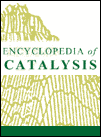Kinases
Abstract
Kinases are enzymes that catalyze the transfer of a group from ATP to a phosphoryl acceptor, converting it into a phosphate ester. For protein kinases the phosphoryl acceptor is a amino acid side chain of a protein substrate. Along with phosphatases, kinases control the phosphorylation of key regulatory residues, which comprises an essential signal transduction and regulatory mechanism for a host of metabolic processes. Despite the large number of kinases identified many similarities exist among them, including the use of a magnesium-nucleotide complex as a substrate and the frequent occurrence of significant conformational changes that accompany catalysis. The magnesium–nucleotide complex substrate is chiral, and those kinases that have been examined display stereochemical preferences. The uncatalyzed transfer of the gamma-phosphoryl group from ATP proceeds by a loose transition state characterized by extensive bond fission between the beta and gamma phosphoryl groups, and a small degree of nucleophilic participation. The question of whether kinases utilize a similar chemical mechanism is not fully settled, although the majority of the experimental evidence supports a similar transition state.



